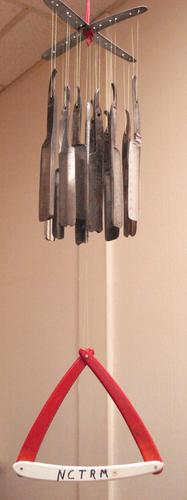Results 11 to 18 of 18
-
04-22-2020, 03:57 PM #11At this point in time...




- Join Date
- Jun 2007
- Location
- North Idaho Redoubt
- Posts
- 27,228
- Blog Entries
- 1
Thanked: 13250
The thinner the grind the less chance of it working
It really is that simple, A heavy 1/4 hollow will dissipate the heat better and also not flex when stropping as much..
What you have is akin to a "Compound Fracture" Try it see what happens
"No amount of money spent on a Stone can ever replace the value of the time it takes learning to use it properly"
Try it see what happens
"No amount of money spent on a Stone can ever replace the value of the time it takes learning to use it properly"
Very Respectfully - Glen
Proprietor - GemStar Custom Razors Honing/Restores/Regrinds Website
-
04-22-2020, 04:17 PM #12Senior Member




- Join Date
- Dec 2012
- Location
- Egham, a little town just outside London.
- Posts
- 3,857
- Blog Entries
- 2
Thanked: 1083
To be honest the time spent trying to fix that would be better spent looking for a Bengall that can be made to shave.
-
04-22-2020, 05:36 PM #13Senior Member



- Join Date
- Oct 2010
- Posts
- 26,211
Thanked: 8626
..........................

-
04-22-2020, 05:47 PM #14Senior Member



- Join Date
- Apr 2012
- Location
- Diamond Bar, CA
- Posts
- 6,553
Thanked: 3215
The pieces are out of alignment, is that because they are under tension and binding or bent?
Either way, that may be an issue trying to get them realigned without causing further cracking. Even if you were to get the parts aligned, and brazed or soldered, I believe you would still have an edge issue.
But, you have nothing to lose by trying. Watch your heat, the thin edge will heat quickly as opposed to the belly.
Do post your results, Good Luck.
-
04-22-2020, 06:51 PM #15"My words are of iron..."


- Join Date
- Oct 2006
- Posts
- 1,898
Thanked: 995
The distortion Euclid sees (me too) suggests that this blade is under some internal stress. That potentiates cracks like this developing in the first place. Heating this blade is going to inject additional stress that could cause more movement of the material and worsen the cracking. Heat treatment, because of the change in the carbide crystals induces tension into the steel. On a larger scale, the heat treatment of a Japanese sword for example, the blade goes into the water straight and comes out with that desirable curve in it. On a smaller scale, say this razor, that tension in the steel is still there but over a much shorter distance. Not all "bellied" razors were ground that way deliberately. I suspect many a happy accident during the heat treatment helped that feature along.
The vertical crack is through the hardened portion of the blade. The horizontal crack is most likely the zone between hard martensite and less hard pearlite or other formations on this blade.
If this was an historical piece and valuable as a display you might consider filling the defect to stabliize it but not to shave with. Museums do this all the time.
As a smith, the razor is toast. The blade is too thin to try any kind of higher temperature fix, the lower temperature solders are right at the cusp of the tempering range for these old steels. As a grinder you will have to remove all the fractured material and you're left with a half inch razor.
For the money and time you will spend learning, it's completely subjective how much value you will gain versus the loss of this blade.
This is not to discourage learning. If you try to solder it, You have to consider that heat is moving into areas around the crack you do not want heat to get into. Get a tube of Heat Fence or the like. It will save the parts of the blade that heat could damage before you can remove your hand-soldering iron to stop it.
There are plenty more razors to find in much better shape.Last edited by Mike Blue; 04-22-2020 at 06:59 PM.
“Nothing discloses real character like the use of power. Most people can bear adversity. But if you wish to know what a man really is, give him power.” R.G.Ingersoll
-
04-23-2020, 02:37 AM #16Junior Member

- Join Date
- Feb 2020
- Location
- Sydney
- Posts
- 3
Thanked: 0
This is probably a stupid question and I am going to get my bum flamed, and I am not a boilermaker, but couldn't you weld the crack in this Bengall. Yeah I realise that if you connected an electrode to one end and one touch with the welding rod would probably dissolve the whole thing, but isn't there other methods you could use?
cheers
-
04-23-2020, 02:46 AM #17Truth is weirder than any fiction..


- Join Date
- Jun 2012
- Location
- Land of the long white cloud
- Posts
- 2,946
Thanked: 581
 .....
Into this house we're born, into this world we're thrown ~ Jim Morrison
.....
Into this house we're born, into this world we're thrown ~ Jim Morrison
-
04-23-2020, 03:42 AM #18

If you take the razor over the max temper temperature for the desired hardness, you will be making the razor softer. The steel is too thin to reharden, which (to not get too geeky here) involves heating the steel above a transformation point, then quenching, which is rapid cooling that results in a different crystal structure in the steel. Just to give you an idea of how hot the steel must be heated, a magnet no longer even sticks to the steel when it is that hot. Typical temps depending on the alloy are 1450f to 1600f. The rapid cooling of the quench is very stressful, and very thin steel does not survive. It will warp, crack, even shatter. A razor early in it's manufacture is capable of withstanding and benefiting from this heat treatment. Once final grinding has been performed, it is too thin.
The hardened steel then must be tempered, to restore some of its resiliency and toughness. Hardness alone does not make a good razor. Fresh from heat treating, the razor is prone to cracking and chipping. Tempering consists of taking the steel up to a temperature typically for razors between 350f and 400f, some steels at lower or higher temps. If you overheat the steel, you push the temper into a softer range.
Welding of course brings steel local to the weld up to the melting point, considerably above tempering temperature, even higher than critical temp for heat treating. Once done, to a finished razor, the process cannot be reversed or repeated to good result. To weld a crack on a razor would also heat the entire blade above temper. And you would want a VERY tiny electrode LOL! If you maintained cooling at the edge, the temperature differential would probably shatter the razor. Some sort of spot welding technique using a capacitive or inductive discharge might work in a controllable manner and minimize blade heating but enough? I am thinking not. Of course, you could try. You could investigate this yourself if you are up to learning a lot of stuff and doing a lot of experimentation. I don't believe anyone else has done this successfully.
So, the only other metallic bonding involving melting and flowing that seems to have a chance of success would be low temperature soldering. For the most part, though, we just don't bother. There are other razors more worthy of effort, and requiring less of it.


 25Likes
25Likes LinkBack URL
LinkBack URL About LinkBacks
About LinkBacks






 Reply With Quote
Reply With Quote
